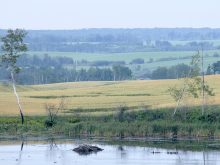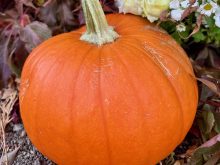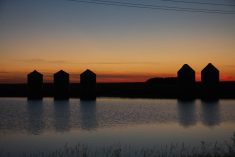Being a Thanksgiving baby, I look forward to the fall celebration surrounding Thanksgiving day. I always knew the family gathering was not just in honour of my birthday but also to celebrate the end of the growing season and to thank God for His blessings and bounty.
My mother especially enjoyed preparing a festive meal with the produce from her garden. I think it gave her a great sense of satisfaction to serve the food that she had sown, tended, harvested and prepared.
The pumpkins and squash were some of my favourites to pick. My brothers and I would pull our little wagon out to the garden and search under the big leaves for the hidden treasures.
Read Also

Rural Manitoba resources slim on natural disaster planning
A study from Brandon University’s Rural Development Institute has found that many rural and small municipalities don’t have the staff or resources to make formal climate plans against natural disaster.
Some of the larger pumpkins would be saved for jack-o’-lantern carving later in October. The smaller sugar pumpkins would be turned into pies and muffins. We all thought that Mom made the best pumpkin pies. But one year they didn’t seem to measure up to her usual standard. When we questioned her she said, rather sheepishly, that what we were eating were actually pumpkin pies and what we were used to eating were really squash pies.
After that, it really didn’t matter. We just enjoyed her pies.
The fall before my mother died she was helping me prepare pumpkins I had grown for pie. Cutting the hard rind was too hard for her to do. We solved the problem by cutting the pumpkins in two, scooping out the seeds and fibres and then placing them cut side down on cookie sheets with a little water. We placed the pumpkins in a 350 F (180 C) oven for about 30 minutes, or until they were soft. After they cooled, the pulp easily scooped out and was ready to be made into pie fillings or frozen for later use.
A few years ago our community of Rosetown, Sask., hosted a fall festival that included a pumpkin pie baking and eating contest. It was great fun watching our son, Mike, trying to beat one of his schoolteachers in the pumpkin pie eating contest.
Prize-winning pie
This is Gwenda Moreside’s winning pumpkin pie recipe, which is similar to my mother’s. It has become my favourite. I have made it using pumpkin, buttercup or acorn squash.
1 cup sugar 250 mL
1 tablespoon flour 15 mL
1/4 teaspoon salt 1 mL
1 teaspoon cinnamon 5 mL
1 teaspoon ground 5 mL
ginger
1/2 teaspoon nutmeg 2 mL
11/2 cups cooked 375 mL
pumpkin or squash
1/2 cup milk 125 mL
3 eggs, beaten
Combine sugar, flour, salt, cinnamon, ginger and nutmeg in a large bowl. Stir in pumpkin, milk and beaten eggs.
Pour into an unbaked pie shell. Bake at 425 F (220 C), or 400 F
(200 C) for a Pyrex pie plate, for 15 minutes. Reduce the heat to 350 F (180 C), or 325 F (160 C) for Pyrex, for 45 minutes or until a knife comes out clean when inserted in the centre. When cooled, top with whipped cream, and sprinkle with nutmeg before serving.
How to set your table
Many young people are uncertain about the placement of cutlery when setting a table.
On the right side of the plate, place the entree knife with the blade facing in toward the plate. To the right of the knife place the teaspoon. To the right of the teaspoon, place the soup spoon.
To the left of the plate, place the entree fork and then the salad fork. If you are using a bread plate you may place it either to the left of the forks or slightly above them. A bread and butter knife can either be placed on the bread plate or above the dinner plate. In either case the blade should be facing toward the dinner plate. The glasses go above the knives with the water glass closest to the plate. Wine glasses will go to the right of the water glass. A napkin may go on the dinner plate or be placed to the left of the forks.
Pumpkin nutrition
The bright orange colour of pumpkin means that it is loaded with an important antioxidant, beta-carotene.
Beta-carotene is one of the
plant carotenoids that are converted to vitamin A in the body. In the conversion to vitamin A, beta-carotene performs many functions that are important to our overall health.
Research indicates that a diet rich in foods containing beta-carotene may reduce the risk of developing certain types of cancer and offers protection against heart disease. Beta-carotene offers protection against other diseases as well as some degenerative aspects of aging.
For some people, especially the kids, part of the fun of cleaning a pumpkin or squash is getting your hands inside and pulling out the seeds and fibres. Don’t waste the seeds because they make a healthy snack or they can be added to baking or used as a garnish on soups and salads. All seeds from pumpkins or squash are edible.
Pumpkin seeds are also known as pepitas in Mexico and the southern United States.
Toasted squash seeds
pumpkin or squash seeds
cooking spray or butter
salt or other seasoning such
as cayenne, garlic, onion
powder
Method 1:
Rinse seeds and separate all pulp and fibre from seeds. Let seeds dry. Spray cookie sheet with oil or coat seeds with melted butter. Spread seeds on a cookie sheet in a single layer. Sprinkle with salt or other seasoning, if desired. Roast at 250 F (120 C) for about an hour, stirring every 15 to 20 minutes until golden brown. Watch so they don’t burn. If the seeds are dry, you can increase the temperature to 300 F (150 C) and reduce the cooking time.
Let cool before eating. The shells are edible as well as the seed inside. Store in an airtight container at room temperature for up to three months or in the refrigerator up to one year, or freeze.
Method 2:
If you like the seeds saltier, soak overnight in salted water, with one tablespoon (15 mL) pickling salt dissolved in one cup (250 mL) boiling water. Let dry overnight. Then roast as per above.
Microwave method:
Rinse one cup (250 mL) of seeds in water to remove some of the fibres, then pat seeds dry with paper towel. Place two tablespoons (30 mL) butter in a two quart (two L) rectangular dish and microwave on high 30 seconds. Stir in seeds to coat; spread evenly in dish. Microwave on high about eight minutes or until toasted, stirring every two minutes. Sprinkle with salt or other seasonings. Cool before storing.
Skillet method:
Toast pumpkin seeds by placing seeds in a dry skillet over medium heat. Move the skillet back and forth over the heat, stirring with a wooden spoon. This will toast them evenly and prevent burning. When they give off a nutty aroma they are ready.
Butternut squash bake
1/2 cup mayonnaise 25 mL
1 egg, lightly beaten
1 teaspoon sugar 5 mL
salt and pepper, to taste
1/2 cup crushed saltines 125 mL
(about eight crackers)
2 tablespoons grated 30 mL
parmesan cheese
1 tablespoon butter, 15 mL
melted
2 cups butternut 500 mL
squash, peeled, seeded,
cubed
Place squash in a saucepan and cover with water; bring to a boil.
Reduce heat; cover and simmer for 20-25 minutes or until tender. If I have time, I bake the squash in the skin until tender, then just peel off the skin. It is more flavourful.
Drain well and place in a large bowl; mash squash.
In another bowl, combine the mayonnaise, egg, sugar, salt and pepper. Add squash and mix well.
Transfer to a greased one quart (one L) baking dish.
Combine the cracker crumbs, cheese and butter; sprinkle over top.
Bake uncovered at 350 F (180 C) for 30-40 minutes or until heated through and top is golden brown.
Betty Ann Deobald is a home economist from Rosetown, Sask., and one of four columnists comprising Team Resources. Send correspondence in care of this newspaper, Box 2500, Saskatoon, Sask.,
S7K 2C4 or contact them at team@producer.com.














